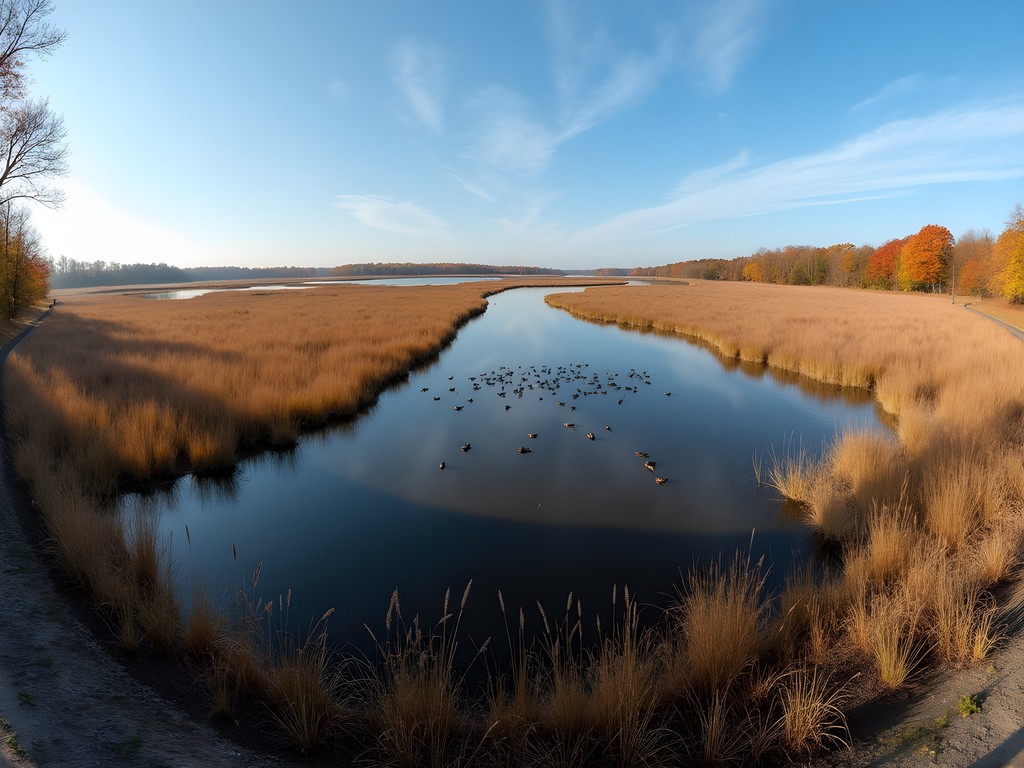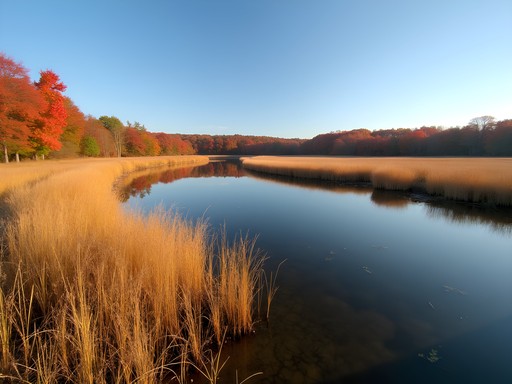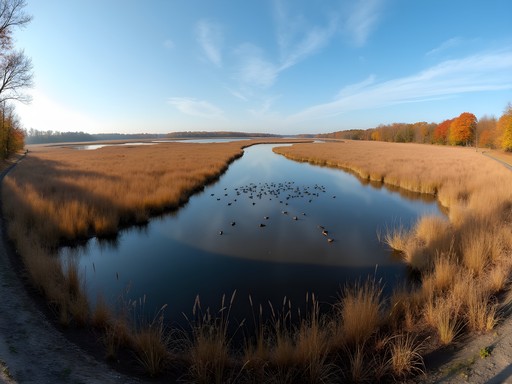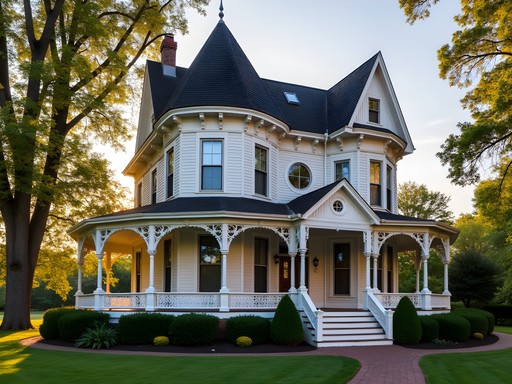Disclosure: This article contains affiliate links. We may earn a commission from purchases at no extra cost to you, which helps our travel content.
Delaware might be the second smallest state in the US, but what it lacks in size, it more than makes up for in ecological diversity. As someone who's spent years studying ecosystems across five continents, I was genuinely surprised by the rich natural tapestry I discovered while visiting family in Middletown last autumn. These pockets of wilderness—many just minutes from town—offer families a perfect weekend escape without breaking the bank. Get ready to trade screen time for green time as we explore these accessible natural wonders that showcase Delaware's surprising biodiversity.
Blackbird Creek Reserve: A Tidal Wonderland
Just 15 minutes from downtown Middletown, Blackbird Creek Reserve offers a fascinating glimpse into the Mid-Atlantic's tidal ecosystem dynamics. This 1,000+ acre natural area features well-maintained trails winding through deciduous forests before opening to spectacular marsh views where the creek meets the Delaware River.
What makes this reserve particularly special in autumn is the stunning contrast between the golden marsh grasses and the vibrant foliage of the surrounding hardwood forest. As a conservation scientist, I'm always drawn to transition zones between ecosystems—these ecotones typically support greater biodiversity than either habitat alone.
During my visit last October, I spent hours observing great blue herons stalking the shallows while osprey circled overhead. The interpretive signs along the main trail provide excellent context about the area's ecological significance without overwhelming younger visitors with too much information.
For families with children under 10, I recommend the 1.5-mile Creek Loop Trail, which offers plenty of wildlife viewing opportunities without being too challenging. Pack a field microscope to examine the fascinating microorganisms in water samples—my nephew was absolutely mesmerized by the tiny aquatic invertebrates we discovered!

💡 Pro Tips
- Visit during low tide for the best wildlife viewing opportunities along the creek
- Download the free Delaware Natural Areas bird checklist before your visit to make a family spotting game
- The trails can get muddy after rain—waterproof footwear is essential
Dragon Run Park: Urban Wilderness for Beginners
One of Middletown's best-kept secrets for families is Dragon Run Park—a surprisingly diverse 123-acre natural area tucked right at the edge of town. What makes this park special is how it packs multiple ecosystems into a compact, easily navigable space that's perfect for nature novices and young explorers.
The 2.5-mile trail system here is mostly flat and well-marked, making it ideal for families with strollers or younger children just developing their hiking legs. During my research visit last fall, I was particularly impressed by the park's wetland boardwalk, which allows visitors to observe freshwater ecology up-close without disturbing sensitive habitat.
For families with younger children, I highly recommend bringing a bug catcher kit. The park's diverse microhabitats support an impressive variety of insects, especially along the meadow sections where native wildflowers attract numerous pollinators even into early autumn.
What fascinated me most was discovering that this park serves as a critical wildlife corridor connecting larger natural areas—a perfect teaching opportunity for explaining habitat fragmentation to older children. The interpretive signs include QR codes linking to kid-friendly ecological information, a thoughtful touch for curious young naturalists.

💡 Pro Tips
- The eastern trail entrance has the best parking and restroom facilities
- Bring a field guide to identify the diverse plant species
- Visit on weekday mornings to avoid weekend crowds and increase wildlife sighting chances
Augustine Wildlife Area: Delaware's Hidden Ecological Treasure
Just a 20-minute drive from Middletown, the Augustine Wildlife Area offers families a chance to explore one of Delaware's most ecologically significant—yet surprisingly uncrowded—natural spaces. Spanning over 3,000 acres with multiple access points, this vast preserve feels worlds away from the suburban landscape surrounding Middletown.
What makes Augustine particularly special for autumn exploration is its remarkable habitat diversity. In a single afternoon, families can experience deciduous forests, freshwater marshes, and tidal wetlands—each with its own distinct ecosystem dynamics and wildlife communities.
During my research visits, I've been consistently impressed by the area's bird diversity. Fall migration brings an impressive array of waterfowl and songbirds, making this an excellent destination for budding young ornithologists. Even for non-birders, spotting a majestic bald eagle (they nest in several locations throughout the preserve) creates an unforgettable wildlife encounter.
For families with older children who can manage longer hikes, the 3-mile Boyd's Corner Loop provides the most comprehensive ecological tour. Pack a water filter bottle to stay hydrated without carrying excessive water weight—a game-changer for longer family explorations.
What I love most about Augustine is how it demonstrates successful habitat restoration. Several areas that were once agricultural fields have been restored to native wetlands, creating a living laboratory for understanding ecological succession and conservation principles.

💡 Pro Tips
- The Port Penn Road entrance offers the most family-friendly trails and facilities
- Bring a spotting scope to observe waterfowl without disturbing them
- Download the free Delaware Wildlife Area map before visiting as cell service can be spotty
Cedar Swamp Wildlife Area: Ancient Forests and Primeval Landscapes
For families seeking a more immersive wilderness experience, Cedar Swamp Wildlife Area offers a fascinating glimpse into what Delaware's landscape looked like centuries ago. Located about 25 minutes from Middletown, this 5,500-acre preserve contains some of the state's most pristine Atlantic white cedar swamps—an increasingly rare ecosystem type that supports numerous specialized plant and animal species.
What makes this area particularly magical in autumn is the mysterious quality of light filtering through the dense evergreen canopy, creating an almost primeval atmosphere. The contrast between the dark cedar waters (stained by natural tannins) and the vibrant fall colors of surrounding deciduous trees creates breathtaking scenes that even my professional camera struggled to capture adequately.
During my research visit last October, I was struck by how this landscape engages all the senses—the earthy fragrance of the cedar trees, the hollow drumming of pileated woodpeckers echoing through the forest, and the soft sponginess of the moss-covered ground. For children accustomed to more manicured natural spaces, Cedar Swamp offers an authentic wilderness immersion that sparks imagination and curiosity.
For families with children who enjoy wildlife tracking, bring a tracking guide to identify the numerous animal signs along the trails. The moist soil throughout the preserve captures perfect impressions of deer, fox, raccoon, and occasionally river otter tracks.
Be prepared for slightly more challenging trail conditions here—a hiking stick provides helpful stability on the occasionally uneven boardwalks that protect the sensitive habitat while allowing visitor access.

💡 Pro Tips
- The Collins Beach Road entrance provides the most accessible family-friendly trails
- Wear long pants and apply eco-friendly insect repellent even in autumn
- Pack binoculars for each family member to enhance wildlife spotting opportunities
Final Thoughts
What continues to amaze me about the natural areas surrounding Middletown is how they offer such ecological diversity within such a compact region. From the tidal marshes of Blackbird Creek to the ancient cedar forests, these accessible wilderness spaces provide families with opportunities for authentic nature connection without requiring extensive travel or expensive equipment.
As a conservation scientist, I'm particularly encouraged by how these protected areas are being managed to balance public access with habitat preservation. The interpretive materials at most sites do an excellent job explaining complex ecological concepts in ways that engage visitors of all ages.
Whether you're a Middletown resident looking for weekend adventures or a visitor seeking to experience Delaware beyond its more publicized coastal attractions, these natural areas deserve a prominent place on your autumn exploration calendar. Pack some snacks, grab a field guide, and prepare to be surprised by the ecological treasures hiding in plain sight. And remember—each family that develops a deeper connection to these special places helps ensure their protection for generations to come.
✨ Key Takeaways
- Delaware's natural areas around Middletown offer surprising ecological diversity perfect for family exploration
- Fall provides optimal conditions with comfortable temperatures, reduced insect activity, and beautiful foliage
- These accessible wilderness areas require minimal equipment and cost, making them perfect for budget-friendly weekend adventures
📋 Practical Information
Best Time to Visit
Mid-September through early November
Budget Estimate
$0-$50 (most areas have free admission)
Recommended Duration
Half-day to full weekend
Difficulty Level
Easy















Comments
Dylan Turner
Having spent considerable time analyzing mid-Atlantic conservation areas, I find your assessment of Augustine Wildlife Area quite accurate. What many visitors overlook is the remarkable seasonal variation. The fall migration brings spectacular waterfowl diversity, while spring showcases rare ephemeral wildflowers in the forested sections. For those seeking luxury accommodations nearby, I recommend staying in Historic New Castle and making day trips to these preserves. The contrast between Delaware's colonial heritage and these pristine natural areas provides a fascinating juxtaposition that's uniquely characteristic of the region's identity.
wildvibes
When's the best time to see those wildflowers you mentioned?
Dylan Turner
Mid-April through early May is prime time for spring ephemerals in Augustine. Look for trout lilies and Virginia bluebells along the eastern trails.
escapepro
OMG Dragon Run Park is such a hidden gem!!! Went there last weekend and saw THREE bald eagles! The trails were super easy to follow and not crowded at all. Can't believe this place isn't more famous!
sunnyninja
Bald eagles?! Now I need to go!
Megan Martin
I had a conference in Wilmington last month and took an extra day to explore Blackbird Creek Reserve on your recommendation. The tidal marshes were absolutely stunning at sunset! I was able to photograph three different species of herons in one evening. The boardwalk trails make it surprisingly accessible even in business attire (though I did change into my hiking shoes for the longer paths). The staff was incredibly knowledgeable about the migratory bird patterns too.
wildone
Is Blackbird Creek Reserve good for kids? Planning a family trip next month.
Audrey Mason
Absolutely! The trails are mostly flat and there's a great visitor center with kid-friendly exhibits about the local ecosystem. Just bring bug spray if you're visiting the marshy areas!
wildone
Thanks Audrey! Will definitely pack the bug spray.
escapelegend
Never thought Delaware had so many cool nature spots! Definitely adding these to my list.
Amit Sullivan
Audrey, your post took me right back to my unexpected Delaware adventure last spring! I was only passing through on my way to Philadelphia when I stumbled upon Blackbird Creek Reserve. What began as a quick stretch-my-legs stop turned into a full day of exploration. The contrast between the serene waterways and the vibrant meadows reminded me of certain wetland preserves back home in New Zealand, though with entirely different species. I ended up photographing a family of river otters for nearly an hour - they seemed completely unbothered by my presence. For anyone planning to visit, I'd recommend the field guide which helped me identify numerous plants and creatures I'd never encountered before. The ecological diversity within such a compact region is truly remarkable!
winterbackpacker
River otters?! Lucky you! Been to Blackbird Creek 3 times and never spotted them.
Amit Sullivan
I was there very early, just after sunrise - I think that was key. The morning light on the creek was absolutely stunning too!
cityblogger751
Just got back from Blackbird Creek Reserve last weekend and was blown away! The tidal marshes were teeming with birds - spotted at least 12 different species. The boardwalk trail is perfect for amateur birdwatchers like me. Didn't make it to Augustine Wildlife Area this time, but definitely adding it to my list for spring. Audrey, your description of the ancient forests at Cedar Swamp has me intrigued - is fall the best time to visit there?
Amit Sullivan
I visited Cedar Swamp in both summer and fall last year, and fall is definitely magical. The colors reflecting in the swamp waters create this otherworldly atmosphere. Just bring good waterproof boots - the trails can get quite muddy after rainfall!
cityblogger751
Thanks for the tip, Amit! Will definitely pack my boots then.
Venture X
Premium card with 2X miles, $300 travel credit, Priority Pass